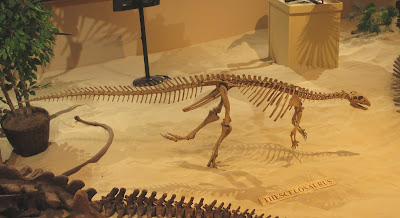I made no post last week because I was traveling for work. Generally, I don't have the time to work on a post while traveling, and this was no exception. In order to get the most bang for our buck on work travel, we try to schedule as many projects as possible, and this trip was no exception. I had four separate projects scheduled over eleven days.
I headed west from St. Paul on Wednesday, May 29, and stayed overnight in Murdo, South Dakota on the way to my first stop,
the Mammoth Site of Hot Springs. I was going there not as a tourist, but to examine and copy field notes made by the late Larry Agenbroad concerning the
mammoths of Channel Islands National Park, in preparation for an upoming project. I did take a few more touristy photos, though.
 |
| This is a cast of the 1994 pygmy mammoth specimen recovered from Santa Rosa Island. You can get an idea of the scale from the bench in the upper left. |
 |
| This is part of the famous in situ accumulation of mammoths. |
From there, I drove to Casper, Wyoming, for the
11th Conference on Fossil Resources, held at Casper College. I gave a talk on the paleontology of
St. Croix National Scenic Riverway on Saturday, May 31. Casper College is known in paleontological circles for the
Tate Geological Museum. There just happened to be another mammoth there:
On Sunday, June 1, I left Casper and drove to Hulett, Wyoming, in advance of working at nearby
Devils Tower National Monument for several days. At some point this summer I'll probably get around to a post on the bedrock geology of this monument. The Tower dominates a landscape of weathered sedimentary rock dating to the
Permo-Triassic (the Spearfish Formation is hard to place) and Jurassic. The red beds of the Spearfish Formation are well-exposed in the southern and eastern parts of the monument. They are followed by the white and red beds of the Gypsum Spring Formation (poorly exposed) and four divisions of the Sundance Formation. In ascending order, these are the Stockade Beaver Shale, Hulett Sandstone, Lak, and Redwater Shale members. Most of these units are recessive, with the exception of the Hulett Sandstone Member, which forms prominent yellowish sandstone bluffs. These bluffs make it a little easier to observe the position of the Stockade Beaver Shale Member than it would otherwise be: it forms light grayish to yellowish-brownish slopes of weathered material beneath the bluffs.
 |
| The bright red of the Spearfish, capped by a bit of Gypsum Spring, overlooking the Belle Fourche River near the entrance of DETO. |
 |
| Looking up at a bluff of resistant Hulett Sandstone. The Red Beds Trail is great if you want to get a sense of most of the different units. |
 |
| And, of course, there is the Tower itself, here viewed from the tranquility of the Joyner Ridge Trail in the northwest part of the park. |
On Thursday, June 6, I left Hulett and drove to Dickinson, North Dakota, so I could attend a meeting the next day on a planned project at
Theodore Roosevelt National Park. Theodore Roosevelt National Park's badlands belong to the Paleocene-aged Fort Union Group, the same geologic unit that also is the source of the Science Museum of Minnesota's Wannagan Creek fossils.
 |
| The banding of the beds is characteristic of paleosols, or fossil soils. Scattered lenses of sandstone are river channels. |
After the meeting, I had some time to myself in Dickinson, so I also stopped at the
Badlands Dinosaur Museum.
Finally, I drove home from Dickinson on Saturday, June 8. Look for the conclusion to the titanosaur osteoderm series next week!








No comments:
Post a Comment